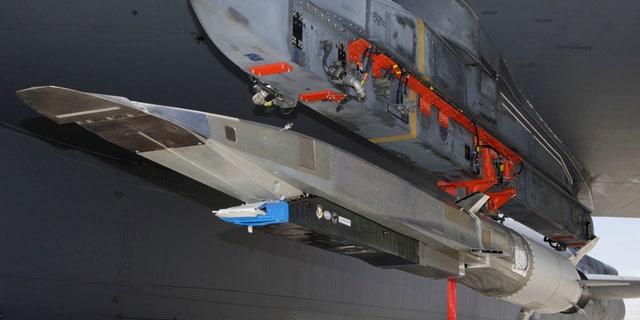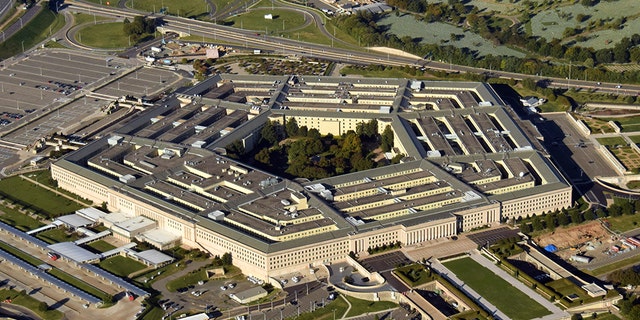Ad Blocker Detected
Our website is made possible by displaying online advertisements to our visitors. Please consider supporting us by disabling your ad blocker.
The revelation that China has advanced in producing hypersonic weapons has renewed calls for the U.S. armed forces to invest equally in hypersonic weapons as very well as the capability to combat these weapons.
The exam of a Chinese hypersonic missile in August appeared to capture U.S. military officers by shock, with one individual allegedly expressing the U.S. experienced “no idea how they did this.”
What are hypersonic weapons, and how fearful must the American armed forces be by China’s new take a look at?
A Hypersonic Air-respiration Weapons Notion (HAWC) missile in observed in an artist’s conception. Raytheon Missiles & Defense/Handout by way of REUTERS.
HYPERSONIC WEAPONS
Hypersonic weapons are broadly outlined as any auto or missile that moves at Mach 5 – five situations the speed of seem, or about 3,800 miles for each hour. Intercontinental ballistic missiles, which have existed for some time: Russia, the United States, China and – most a short while ago – North Korea have all analyzed ICBMs of this pace or better, in accordance to Popular Science.
The U.S. has actively pursued the advancement of these kinds of weapons considering that the 2000s. Joint Chiefs of Personnel and former Commander of U.S. Strategic Command Typical John Hyten has stated, these weapons could allow “responsive, long-selection, strike choices from distant, defended, and/or time-essential threats [such as road-mobile missiles] when other forces are unavailable, denied obtain, or not chosen.”
DOES TAIWAN’S Armed service STAND A Possibility From CHINA? Number of Consider SO
These missiles fly up into place and journey some distance ahead of re-getting into the atmosphere as the missile aims for a target. Autos that abide by this kind of flight sample are recognized as hypersonic glide motor vehicles.
The next variation of this kind of weapons would be the hypersonic cruise missile, which can fly by means of the atmosphere. The heat created by Mach 5 flight, and the gas required to propel at these sustained speeds, pose the biggest hurdle to improvement.

Chinese International Ministry spokesman Zhao Lijian speaks at a information convention in Beijing, China April 8, 2020. REUTERS/Carlos Garcia Rawlins
CHINA’S Take a look at
China has earlier demonstrated the ability to deploy ICBM as early as 2014, John Venable of D.C.-centered assume-tank The Heritage Basis explained to Fox News.
“The Chinese began this certain glide car in 2014,” Venable stated. “They experienced nine successful checks considering that then, roughly. The strategy that this is new, that this is a revelation that caught the U.S. governing administration by shock is a misnomer.”
EX-SAUDI Official Promises TO HAVE INTEL, Video clip OF CROWN PRINCE’S Death THREATS Towards Previous MONARCH
Studies adhering to the take a look at indicated that the concern is that the missile – noted as “nuclear able” – was able to circle the Earth prior to heading for its focus on. The motor vehicle in dilemma seems to deploy an orbital bombardment system, which would strategy a target at a lower altitude than an ICBM, in accordance to The Washington Post.
The factors of this examination are nothing new, but taken collectively, they pose a new obstacle for the U.S. in developing countermeasures. The weapon provides China with a theoretically unlimited assortment of deployment.
“It was not a missile, it was a area vehicle,” ministry spokesman Zhao Lijian told a frequent press briefing in Beijing when questioned about the report, in accordance to Reuters.

A U.S. Air Pressure B-52 prepares to carry the X-51 Hypersonic Car or truck out to the selection for a launch examination from Edwards AFB, California in this handout image provided by the U.S. Air Power on May well 1, 2013. The X-51 achieved Mach 5.1 traveling 230 nautical miles in just more than six minutes generating this test the longest air-respiration hypersonic flight ever. REUTERS/Bobbi Zapka/USAF/Handout through Reuters
Creating Trend
These weapons capabilities have understandably stirred concern among the authorities officers. Sen. Michael Bennet, D-Colo., explained previous week that “China’s capabilities are extraordinary.”
“I hope it under no circumstances will come to that, but we want to make absolutely sure that we’ve bought a tactic and approach to neutralize these threats as they crop up,” Bennet explained to Protection One.
In the same way, Rep. Jason Crow, D-Colo., argued that China’s examination “underscored the essential choice President Biden built to close our battle functions in Afghanistan” so the nation can emphasis on dealing with “the rising and the most evolving threats.”
Uncommon Stability LAPSE Results IN Guy SLAPPING IRANIAN GOVERNOR
The conversation about hypersonic weapons might be newer for the mainstream, but it is a subject matter that navy officers have buzzed about for some time.
In 2019, an post by the nonpartisan Arms Handle Affiliation argued for the needed concentration on hypersonic weapons as the vital to protecting pace with China and trying to keep Russia at arm’s length.
“China’s hypersonic weapons growth outpaces ours,” Admiral Henry Harris, previous commander of the U.S. Indo-Pacific Command, explained to Congress ahead of leaving his article to think his job as U.S. Ambassador to South Korea, which lasted from 2018 to 2021. “The United States is not yet executing all that we have to have to do to answer to hypersonic missile threats.”
“I did not choose this position to get to parity with adversaries,” he mentioned. “I want to make them be concerned about catching up with us once more.”

US Pentagon in Washington DC building seeking down aerial perspective from above
(iStock)
THE Foreseeable future OF Defense
The Pentagon has presently been working to a new constellation of lower-earth-orbit satellites, which would monitor the route of hypersonic weapons more carefully to provide additional reaction alternatives.
“There’s two huge points [the government] requirements to do,” Venable discussed. “The first matter is to have more satellites that have the capability to keep track of these assets and maximize the fidelity of the sensing.”
“Any time you have a significant flashpoint on the ground, there is an array out there known as the Area-Primarily based Infrared Process, and we can detect just about any major start or explosion on the confront of the Earth, but the capacity to monitor all those once they truly depart the ambiance and commence their trajectory is sophisticated by the movement of these autos,” he explained.
CHINA TO GIVE COVID VACCINE TO Young children AS Younger AS 3
Air Force Col. Kristopher Struve past week echoed equivalent problems, declaring “it’s that ability to provide a warning to our countrywide leadership, what that menace is” that issues officials the most.
China’s aim has thus far appeared to be regional: Michael Griffin, a previous undersecretary of protection for study and engineering, instructed NPR that the new weapon “enables it to extend its impact in the location.”
Griffin explained this sort of a weapon could potentially strike a U.S. ship anyplace on Earth, which is “a actually large deal.”
Simply click Listed here TO GET THE FOX News App
“I am not one to mince text — it is an arms race,” Griffin said. “And critically, we didn’t start it.”